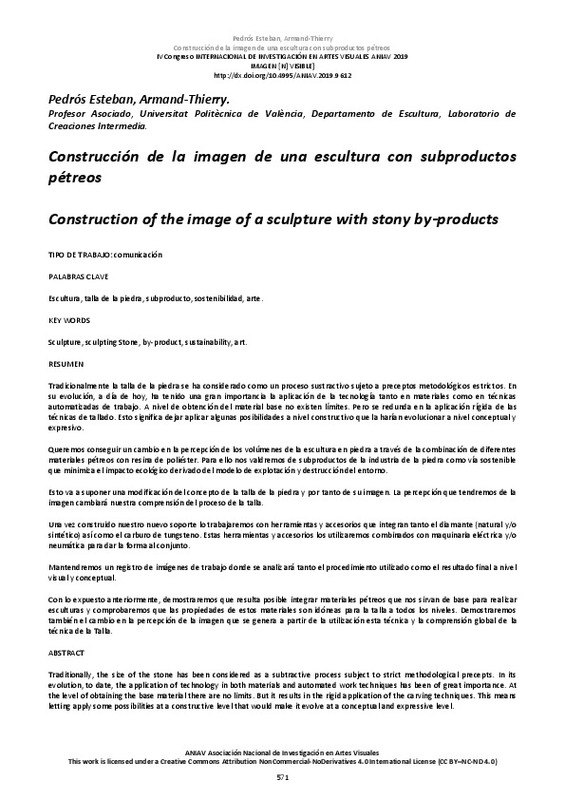|
[ES] Tradicionalmente la talla de la piedra se ha considerado como un proceso sustractivo sujeto a preceptos metodológicos estrictos. En
su evolución, a día de hoy, ha tenido una gran importancia la aplicación de la ...[+]
[ES] Tradicionalmente la talla de la piedra se ha considerado como un proceso sustractivo sujeto a preceptos metodológicos estrictos. En
su evolución, a día de hoy, ha tenido una gran importancia la aplicación de la tecnología tanto en materiales como en técnicas
automatizadas de trabajo. A nivel de obtención del material base no existen límites. Pero se redunda en la aplicación rígida de las
técnicas de tallado. Esto significa dejar aplicar algunas posibilidades a nivel constructivo que la harían evolucionar a nivel conceptual y
expresivo.
Queremos conseguir un cambio en la percepción de los volúmenes de la escultura en piedra a través de la combinación de diferentes
materiales pétreos con resina de poliéster. Para ello nos valdremos de subproductos de la industria de la piedra como vía sostenible
que minimiza el impacto ecológico derivado del modelo de explotación y destrucción del entorno.
Esto va a suponer una modificación del concepto de la talla de la piedra y por tanto de su imagen. La percepción que tendremos de la
imagen cambiará nuestra comprensión del proceso de la talla.
Una vez construido nuestro nuevo soporte lo trabajaremos con herramientas y accesorios que integran tanto el diamante (natural y/o
sintético) así como el carburo de tungsteno. Estas herramientas y accesorios los utilizaremos combinados con maquinaria eléctrica y/o
neumática para dar la forma al conjunto.
Mantendremos un registro de imágenes de trabajo donde se analizará tanto el procedimiento utilizado como el resultado final a nivel
visual y conceptual.
Con lo expuesto anteriormente, demostraremos que resulta posible integrar materiales pétreos que nos sirvan de base para realizar
esculturas y comprobaremos que las propiedades de estos materiales son idóneas para la talla a todos los niveles. Demostraremos
también el cambio en la percepción de la imagen que se genera a partir de la utilización esta técnica y la comprensión global de la
técnica de la Talla.
[-]
[EN] Traditionally, the size of the stone has been considered as a subtractive process subject to strict methodological precepts. In its
evolution, to date, the application of technology in both materials and automated ...[+]
[EN] Traditionally, the size of the stone has been considered as a subtractive process subject to strict methodological precepts. In its
evolution, to date, the application of technology in both materials and automated work techniques has been of great importance. At
the level of obtaining the base material there are no limits. But it results in the rigid application of the carving techniques. This means
letting apply some possibilities at a constructive level that would make it evolve at a conceptual and expressive level.
We want to achieve a change in the perception of the volumes of the sculpture in stone through the combination of different stone
materials with polyester resin. For this we will use as byproducts of the stone industry as a sustainable way that minimizes the
ecological impact derived from the model of exploitation and destruction of the environment.
This is going to suppose a modification of the concept of the size of the stone and therefore of its image. The perception that we will
have of the image will change our understanding of the process of carving.
Once built our new support we will work with tools and accessories that integrate both the diamond (natural and / or synthetic) as
well as tungsten carbide. These tools and accessories will be used combined with electrical and / or pneumatic machinery to give
shape to the whole.
We will keep a record of working images where both the procedure used and the final result at the visual and conceptual level will be
analyzed.
With the above, we will demonstrate that it is possible to integrate stone materials that serve as the basis for sculptures and we will
verify that the properties of these materials are ideal for carving at all levels. We will also demonstrate the change in the perception of
the image that is generated from the use of this technique and the global understanding of the technique of the Size.
[-]
|









